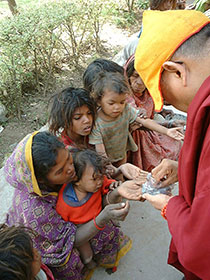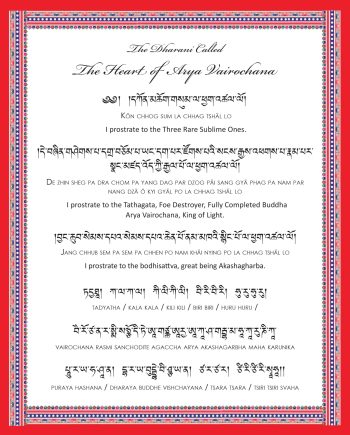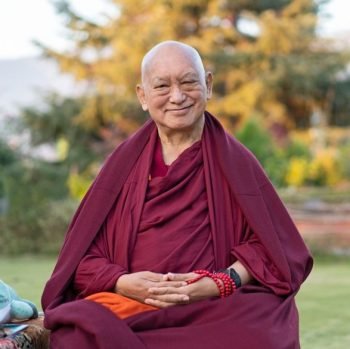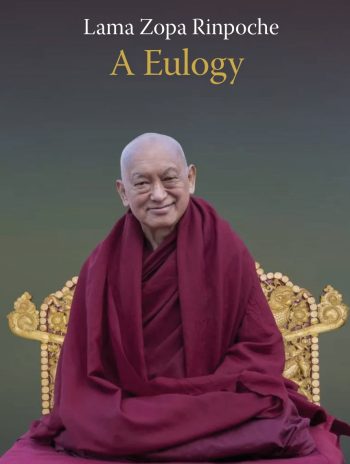- Home
- FPMT Homepage
Foundation for the Preservation of the Mahayana Tradition
The FPMT is an organization devoted to preserving and spreading Mahayana Buddhism worldwide by creating opportunities to listen, reflect, meditate, practice and actualize the unmistaken teachings of the Buddha and based on that experience spreading the Dharma to sentient beings. We provide integrated education through which people’s minds and hearts can be transformed into their highest potential for the benefit of others, inspired by an attitude of universal responsibility and service. We are committed to creating harmonious environments and helping all beings develop their full potential of infinite wisdom and compassion. Our organization is based on the Buddhist tradition of Lama Tsongkhapa of Tibet as taught to us by our founders Lama Thubten Yeshe and Lama Thubten Zopa Rinpoche.
- Willkommen
Die Stiftung zur Erhaltung der Mahayana Tradition (FPMT) ist eine Organisation, die sich weltweit für die Erhaltung und Verbreitung des Mahayana-Buddhismus einsetzt, indem sie Möglichkeiten schafft, den makellosen Lehren des Buddha zuzuhören, über sie zur reflektieren und zu meditieren und auf der Grundlage dieser Erfahrung das Dharma unter den Lebewesen zu verbreiten.
Wir bieten integrierte Schulungswege an, durch denen der Geist und das Herz der Menschen in ihr höchstes Potential verwandelt werden zum Wohl der anderen – inspiriert durch eine Haltung der universellen Verantwortung und dem Wunsch zu dienen. Wir haben uns verpflichtet, harmonische Umgebungen zu schaffen und allen Wesen zu helfen, ihr volles Potenzial unendlicher Weisheit und grenzenlosen Mitgefühls zu verwirklichen.
Unsere Organisation basiert auf der buddhistischen Tradition von Lama Tsongkhapa von Tibet, so wie sie uns von unseren Gründern Lama Thubten Yeshe und Lama Thubten Zopa Rinpoche gelehrt wird.
- Bienvenidos
La Fundación para la preservación de la tradición Mahayana (FPMT) es una organización que se dedica a preservar y difundir el budismo Mahayana en todo el mundo, creando oportunidades para escuchar, reflexionar, meditar, practicar y actualizar las enseñanzas inconfundibles de Buda y en base a esa experiencia difundir el Dharma a los seres.
Proporcionamos una educación integrada a través de la cual las mentes y los corazones de las personas se pueden transformar en su mayor potencial para el beneficio de los demás, inspirados por una actitud de responsabilidad y servicio universales. Estamos comprometidos a crear ambientes armoniosos y ayudar a todos los seres a desarrollar todo su potencial de infinita sabiduría y compasión.
Nuestra organización se basa en la tradición budista de Lama Tsongkhapa del Tíbet como nos lo enseñaron nuestros fundadores Lama Thubten Yeshe y Lama Zopa Rinpoche.
A continuación puede ver una lista de los centros y sus páginas web en su lengua preferida.
- Bienvenue
L’organisation de la FPMT a pour vocation la préservation et la diffusion du bouddhisme du mahayana dans le monde entier. Elle offre l’opportunité d’écouter, de réfléchir, de méditer, de pratiquer et de réaliser les enseignements excellents du Bouddha, pour ensuite transmettre le Dharma à tous les êtres. Nous proposons une formation intégrée grâce à laquelle le cœur et l’esprit de chacun peuvent accomplir leur potentiel le plus élevé pour le bien d’autrui, inspirés par le sens du service et une responsabilité universelle. Nous nous engageons à créer un environnement harmonieux et à aider tous les êtres à épanouir leur potentiel illimité de compassion et de sagesse. Notre organisation s’appuie sur la tradition guéloukpa de Lama Tsongkhapa du Tibet, telle qu’elle a été enseignée par nos fondateurs Lama Thoubtèn Yéshé et Lama Zopa Rinpoché.
Visitez le site de notre Editions Mahayana pour les traductions, conseils et nouvelles du Bureau international en français.
Voici une liste de centres et de leurs sites dans votre langue préférée
- Benvenuto
L’FPMT è un organizzazione il cui scopo è preservare e diffondere il Buddhismo Mahayana nel mondo, creando occasioni di ascolto, riflessione, meditazione e pratica dei perfetti insegnamenti del Buddha, al fine di attualizzare e diffondere il Dharma fra tutti gli esseri senzienti.
Offriamo un’educazione integrata, che può trasformare la mente e i cuori delle persone nel loro massimo potenziale, per il beneficio di tutti gli esseri, ispirati da un’attitudine di responsabilità universale e di servizio.
Il nostro obiettivo è quello di creare contesti armoniosi e aiutare tutti gli esseri a sviluppare in modo completo le proprie potenzialità di infinita saggezza e compassione.
La nostra organizzazione si basa sulla tradizione buddhista di Lama Tsongkhapa del Tibet, così come ci è stata insegnata dai nostri fondatori Lama Thubten Yeshe e Lama Zopa Rinpoche.
Di seguito potete trovare un elenco dei centri e dei loro siti nella lingua da voi prescelta.
- 欢迎 / 歡迎
简体中文
“护持大乘法脉基金会”( 英文简称:FPMT。全名:Foundation for the Preservation of the Mahayana Tradition) 是一个致力于护持和弘扬大乘佛法的国际佛教组织。我们提供听闻,思维,禅修,修行和实证佛陀无误教法的机会,以便让一切众生都能够享受佛法的指引和滋润。
我们全力创造和谐融洽的环境, 为人们提供解行并重的完整佛法教育,以便启发内在的环宇悲心及责任心,并开发内心所蕴藏的巨大潜能 — 无限的智慧与悲心 — 以便利益和服务一切有情。
FPMT的创办人是图腾耶喜喇嘛和喇嘛梭巴仁波切。我们所修习的是由两位上师所教导的,西藏喀巴大师的佛法传承。
繁體中文
護持大乘法脈基金會”( 英文簡稱:FPMT。全名:Found
ation for the Preservation of the Mahayana Tradition ) 是一個致力於護持和弘揚大乘佛法的國際佛教組織。我們提供聽聞, 思維,禪修,修行和實證佛陀無誤教法的機會,以便讓一切眾生都能 夠享受佛法的指引和滋潤。 我們全力創造和諧融洽的環境,
為人們提供解行並重的完整佛法教育,以便啟發內在的環宇悲心及責 任心,並開發內心所蘊藏的巨大潛能 — 無限的智慧與悲心 – – 以便利益和服務一切有情。 FPMT的創辦人是圖騰耶喜喇嘛和喇嘛梭巴仁波切。
我們所修習的是由兩位上師所教導的,西藏喀巴大師的佛法傳承。 察看道场信息:
- FPMT Homepage
- News/Media
-
- Study & Practice
-
-
- About FPMT Education Services
- Latest News
- Programs
- New to Buddhism?
- Buddhist Mind Science: Activating Your Potential
- Heart Advice for Death and Dying
- Discovering Buddhism
- Living in the Path
- Exploring Buddhism
- FPMT Basic Program
- FPMT Masters Program
- FPMT In-Depth Meditation Training
- Maitripa College
- Lotsawa Rinchen Zangpo Translator Program
- Universal Education for Compassion & Wisdom
- Online Learning Center
-
- Prayers & Practice Materials
- Overview of Prayers & Practices
- Full Catalogue of Prayers & Practice Materials
- Explore Popular Topics
- Benefiting Animals
- Chenrezig Resources
- Death & Dying Resources
- Lama Chopa (Guru Puja)
- Lama Zopa Rinpoche: Compendium of Precious Instructions
- Lama Zopa Rinpoche: Life Practice Advice
- Lama Zopa Rinpoche Practice Series
- Lamrim Resources
- Mantras
- Prayer Book Updates
- Purification Practices
- Sutras
- Thought Transformation (Lojong)
- Audio Materials
- Dharma Dates - Tibetan Calendar
- Translation Services
- Publishing Services
- Ways to Offer Support
- Prayers & Practice Materials
-
- Teachings and Advice
- Find Teachings and Advice
- Lama Zopa Rinpoche Advice Page
- Lama Zopa Rinpoche: Compendium of Precious Instructions
- Lama Zopa Rinpoche Video Teachings
- ༧སྐྱབས་རྗེ་བཟོད་པ་རིན་པོ་ཆེ་མཆོག་ནས་སྩལ་བའི་བཀའ་སློབ་བརྙན་འཕྲིན།
- Podcasts
- Lama Yeshe Wisdom Archive
- Buddhism FAQ
- Dharma for Young People
- Resources on Holy Objects
- Teachings and Advice
-
-
*If a menu item has a submenu clicking once will expand the menu clicking twice will open the page.
-
-
- Centers
-
- Teachers
-
- Projects
-
-
-
-
*If a menu item has a submenu clicking once will expand the menu clicking twice will open the page.
-
-
- FPMT
-
-
-
-
-
The office is a place for Dharma practice. When one goes to the office, dealing with people, one has to recognize it’s a place to practice lam-rim, the three principles of the path, tantra, and the six paramitas. The six paramitas fit very well for daily life. They offer protection for you. Everything is there.
Lama Zopa Rinpoche
-
-
-
- Shop
-
-
-
The Foundation Store is FPMT’s online shop and features a vast selection of Buddhist study and practice materials written or recommended by our lineage gurus. These items include homestudy programs, prayers and practices in PDF or eBook format, materials for children, and other resources to support practitioners.
Items displayed in the shop are made available for Dharma practice and educational purposes, and never for the purpose of profiting from their sale. Please read FPMT Foundation Store Policy Regarding Dharma Items for more information.
-
-
Lama Zopa Rinpoche News and Advice
13
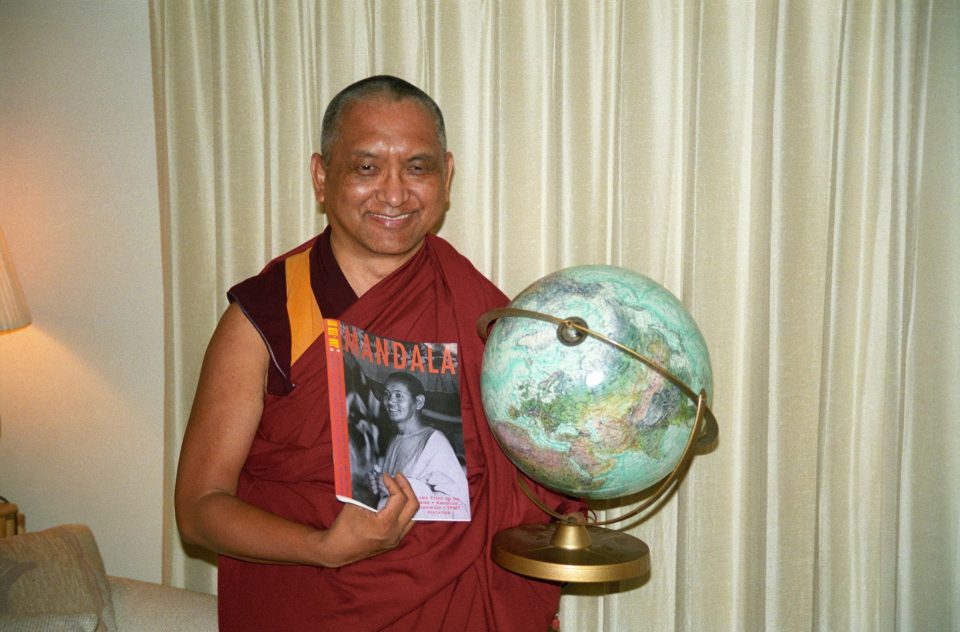
Lama Zopa Rinpoche in California, 1997. Photo by Ven. Roger Kunsang.
Over the years, students have shared stories from Lama Zopa Rinpoche’s travels around the world benefiting others; to offer a glimpse into what it is like to be on the road with Rinpoche, and to witness and participate in Rinpoche’s enlightened activity. These stories offer a glimpse into how Rinpoche used all of the circumstances in daily life, including the time traveling, to practice Dharma and serve others. Today we are sharing a report from 1997 from long-time FPMT student and former director of FPMT Education Services, Merry Colony.
The summer of ’97 could well indicate a new beginning in the travel style of Lama Zopa Rinpoche. Certainly, given the advice of one of his main teachers Ribur Rinpoche and others regarding Rinpoche’s hectic touring schedules and the consequent toll on his health, we should all pray for such.
At a slower pace, with greater autonomy and fewer scheduled events, Roger Kunsang, Roger Munro and our precious Rinpoche left California in the first days of August and embarked on the USA tour, but this time in a luxury conversion Dodge Ram van, maroon of course, complete with custom seats, TV and VCR. On this tour there would not be the constant hum of departure gate announcements, delays at baggage claim carousels or curbside’s anxious check-in crowds. Nor would there be the khatas given in haste amongst rushing onlookers. A great start to what can hopefully become the downsizing of Lama Zopa Rinpoche’s annual travel agenda.
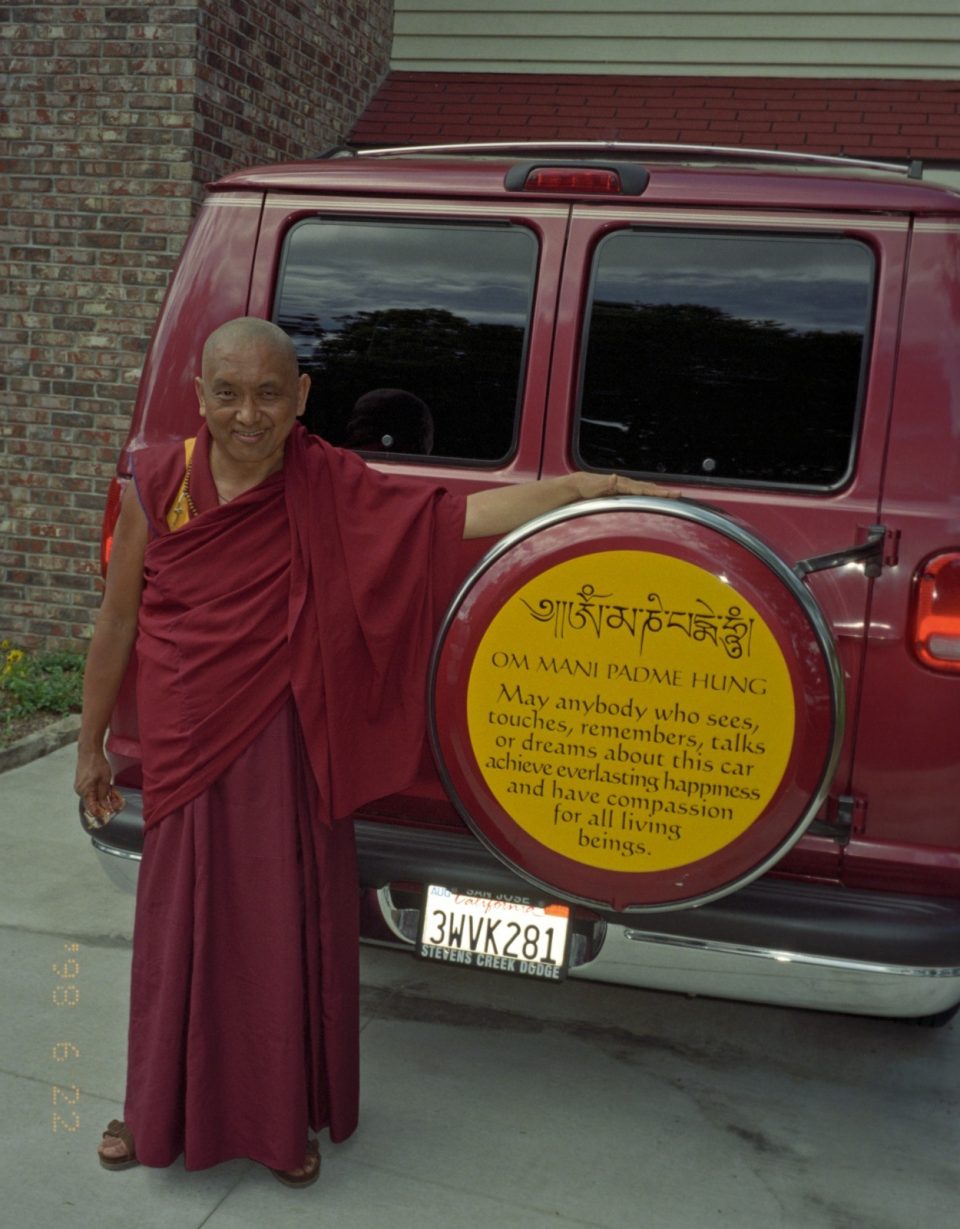
Rinpoche always taking every opportunity from daily life to bless others: The “vajra vehicle” Dodge van, 1998. Photo by Ven. Roger Kunsang.
As a method for giving teaching to us, the style in which Rinpoche traveled, ate and rested provided a whole new market of opportunities for him to show us how to create merit amidst the more ordinary scenery of daily life. The most consistent way in which Rinpoche did this, Roger Munro said, was to make the environment, at every moment, were, into a merit field. That Dodge van, be assured, was power-packed, bestowing blessings on all who were in its reach and providing those within with the means to create merit almost effortlessly. And if there is anything that comes close to death as being a definite in our lives, it is that we will ride in our vehicles. So how to use them for merit? Fill them with holy objects and then circumambulate them at rest strops, parking lots and shopping malls. That’s what Rinpoche did!
The route the entourage followed, starting off in Santa Cruz in California, was first through Nevada where the first night was spent on the side of the road, Rinpoche sitting up all night on the platform bed inside the van, Ven. Roger and Roger on the ground outside. When Roger 2 awoke in the morning, a bit disoriented, the first utterance he made was, “Where are we?” From inside the van a muffled voice replied, “In hell!” For the most part, however, Rinpoche remained quiet as they drove through the desert of Nevada, except to remark now and then on how a particular mountain “looked angry” or another “like an animal with its skin ripped off.” In Arizona Rinpoche was asked if he would like to see the Grand Canyon. “A hole in the ground! What for?” he replied.
When they reached Salt Lake City, Utah the atmosphere within the vajra vehicle and in the surrounding environment changed. There were several rainbows and a thin white cloud resting on the mountains surrounding the city, “as if a kata were draped on them,” Roger M. said. Rinpoche commented that the local deities seemed pleased and then got out to inspect the salt lake, the first interest he’d actively taken in the scenery so far. Roger M. reflected on how in his previous life the Lawudo Lama had made trips by foot to Tibet to buy salt. There may well have been a connection as Rinpoche seemed very interested in how and why and what kind of salt was there. After a visit with the family of Gomo Tulku they continued on to Wyoming and then Nebraska.
It was here, in the flatlands of middle America, that Rinpoche gave one of his best teachings. As it happened there was a Wheel Turning Day, August 7, when all the merits accumulated were multiplied ten million times. There were no stupas nearby, no statues, no Dharma centers. Except of course the unbelievably powerful objects that Rinpoche carries with him, and needless to say Rinpoche’s holy body itself. Within an hour the Motel 8 room where they had spent the previous night was transformed into a gompa and other than to eat lunch in the park nearby and bless the sentient beings living in the Platt river, the three did not leave the hotel room/gompa all day. They circumambulated a small formica table in the room adorned with their mani wheels, statues and the most precious stupa Rinpoche carries containing the Buddha’s relic. They prostrated to the makeshift altar where Rinpoche had set up laminated sheets of Lama Tsong Khapa and Medicine Buddha. And all around they set up water bowls, of the plastic Park Inn variety courtesy of the motel. Then they meditated on the purpose of the perfect human life, and making it worthwhile by accumulating merit on behalf of sentient beings and dedicating all the merits to them. The example shown has to make us ask: Is there really that much I need to make my life worthwhile?
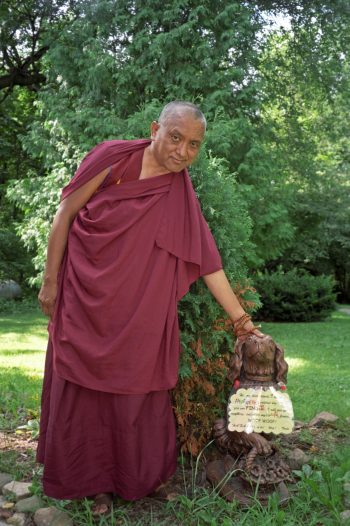
Dog with Dharma message written by Lama Zopa Rinpoche at Deer Park, Wisconsin, USA, 1997. Photo by Ven. Roger Kunsang.
The next stop was Deer Park, Wisconsin, the home of Geshe Sopa Rinpoche, one of Lama Zopa Rinpoche’s teachers. The entourage spent twelve days here, Rinpoche receiving teachings for two hours every day from Geshe-la. At the end Rinpoche offered a long life puja for Geshe Sopa, for which he shopped at the local department store, buying among other things, an Edgewood dinner set. The tsog offering was three tiers of gaudy supermarket cake, one of which had a smily face decorated in three-inch- thick frosting. Geshe-la was extremely pleased. When it came to the part in the puja where the mandala is offered and an original memorized praise is recited to the Lama, the tables were untraditionally turned. Rather than Lama Zopa offering the praise, Geshe Sopa himself spoke a moving praise of Lama Zopa’s extraordinary qualities as a yogi-practitioner. Before leaving Deer Park Rinpoche granted the Vajrasattva empowerment, at the request of Geshe Sopa, to the many students of Geshe-la who were present.
On to Decatur, Illinois. At Tilopa Center Rinpoche taught for three nights on The Three Principal Aspects of the Path followed by a Four-Armed Chenrezig empowerment. At a picnic Rinpoche is known to have given his first tattoo. On the forearm of a tattoo artist Rinpoche wrote, “The moment you remember death all other problems will be solved.” The man went home that night and put the needle and ink to the words. Yet another skillful means of bringing the teachings into our daily life American reality.
By now Ven. Tsenla had joined Rinpoche’s entourage and they drove back West to Osel Shen Phen Ling in Missoula, Montana. Director Deanna Sheriff wrote, “Rinpoche transformed our environment and all who came in touch with him. He has challenged us to build a stupa in Montana for the benefit of all who live here and particularly for the growing Tibetan community. We are delighted to fulfill his vision for us. We are also trying to hold Rinpoche’s vision of a bigger center in our visualizations and we invite students worldwide to pray for our success.” The vajra mobile then headed to the Dharma Friendship Foundation in Seattle for a Vajrasattva empowerment and public talk, then on to San Francisco for another Vajrasattva empowerment sponsored by Tse Chen Ling Center and attended by 200 people.
Being the first stop of a month-long program in California, S an Francisco saw the beginnings of an international audience with several Taiwanese in attendance. From there the venue moved south to Cupertino’s Medicine Buddha’s Healing Center. Here the numbers swelled, with students that had come from New Zealand, Europe, Nepal and Taiwan for the Heruka and Vajra Yogini initiations preceded each night by extensive lam-rim teachings. Rinpoche used Lama Yeshe’s text for the Heruka and would periodically read notes to us that Lama written as well as stopping where Lama had stopped when he had given the initiation years ago. It was a heartfelt touch for those of us who had attended those very memorable initiations.
Land of Medicine Buddha in Soquel hosted the next event, a Palden Lhamo empowerment. Co-director Mark Gatter tells of having lunch with Rinpoche the day of the empowerment when it was discovered that Rinpoche didn’t actually have the text with him. This inspired several Roger-powered long distance cellphone calls from the table until a text was located in Australia. They then returned to the center where the text was faxed through. Only when Rinpoche had started the preparation was it discovered that there were some pages missing. More calls to Australia. Just then three monks from Nalanda Monastery in France arrived, one of them carrying the exact text Rinpoche was in need of. He had brought it as an auspicious offering to the guru! Said Mark: “Don’t you just love this stuff?” The initiation then proceeded without a hitch, the gompa filled with students from all over the world, finishing at 5am.
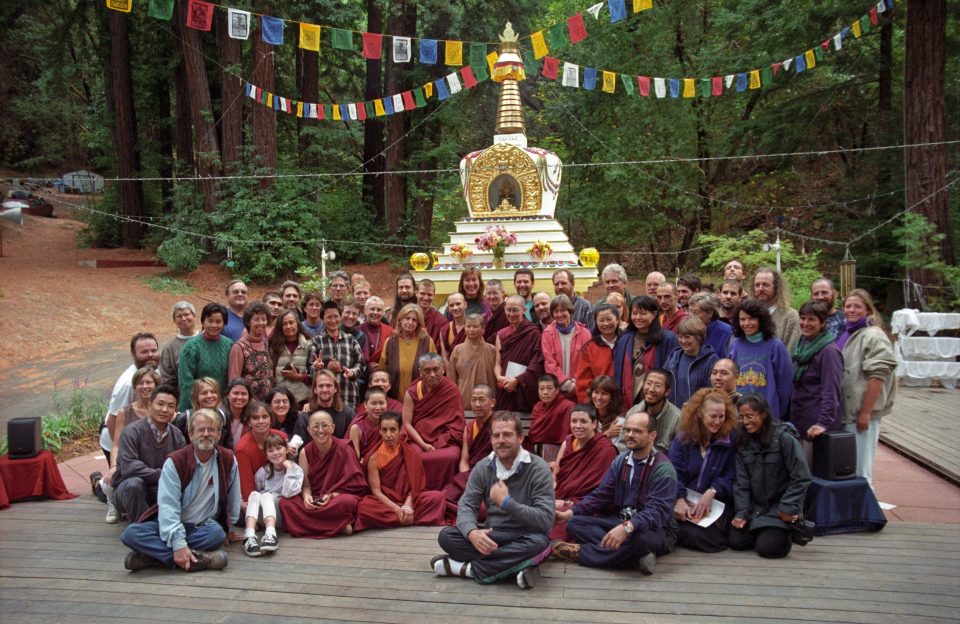
Lama Zopa Rinpoche with Most Secret Hayagriva retreat group at Vajrapani Institute, 1997. Photo by Ven. Roger Kunsang.
And now we bring you to date, where, as of writing, nearby at Vajrapani Institute, the extremely auspicious Dharma event of seventy students and Rinpoche doing a Most Secret Hayagriva retreat is in its final days. Many in attendance had followed the eight days of initiations preceding the retreat which had finished each night between 3 and 5am. When on the first day of retreat Rinpoche announced that this was “not going to be picnic,” a slight panic could be felt in the room. Picnic it hasn’t been (in fact meals have been taken in silence and without undue lagging about). Spiritual feast is more the description. At the start, however, it looked as though Rinpoche may depart early and go to Dharamsala for teachings from His Holiness, but the decision to stay was made when Geshe Sopa advised Rinpoche to remain. From our hearts, thank you Geshe-la!
For twenty-four days, now, we have had the indescribable fortune of getting a taste for how the guru would have us meditate and conduct ourselves in retreat. First session at 5am, as with all sessions, began with extensive motivation and prostrations to the Thirty-five Buddhas followed usually by commentary and then the sadhana either chanted in Tibetan or done silently in one’s own language. Rinpoche had invited Sera Je Geshe Thubten Sonam to come as our puja leader. After session and breakfast 1000 water bowls were offered at the stupa of the most precious Lama Thubten Yeshe. Another session began at 9:30am and another at 3pm. The evening session at seven included commentary as well as extensive torma and tsog offerings. After sometimes forty-five minutes of Rinpoche’s elaborate dedication prayers, we usually got to bed well after midnight.
The amazing thing to experience was how our resistance to the heavy schedule became less and less, and while tiredness always lurked around the edges, it was very sustainable, and it even became enjoyable to be making such effort to make our lives meaningful.
We even had the merit to walk out of the gompa one session and see a seventeen-foot Medicine Buddha tangka hanging from the redwoods behind Lama’s stupa. This was Peter Iseli’s most recent offering (for nearby Land of Medicine Buddha), and Rinpoche honored him that night with praise and presents after extensive offerings and prayers had been made to the tangka Buddhas.
On the last morning of retreat Rinpoche explained that only since his being in the USA did the plan to do this Most Secret Hayagriva retreat take shape. He also said that he did not expect there to be as much interest as there was and that he was pleased with how the retreat went.
Rinpoche then said that he would like to dedicate the positive accumulation to His Holiness. A letter will be sent to His Holiness explaining that this is the first time in the West that a group has done this particular practice and that we would all like to dedicate the merits to be guided by the Compassionate Buddha in all our lives and never to be separate.
Finally Rinpoche paid tribute to Paula Chichester and Roger Munro, who are about to begin their second three-year retreat. “Bearing so much hardship, this is what I am most interested in. Generally people who have done three-year retreat, you don’t see much result, but I can see the improvement, stability. This is the result of having practiced Dharma during the retreat. Anyone can recite mantras but practicing Dharma is very difficult. When there is no development in the mind it is not because one doesn’t have mantras to recite or deity practice to do, it is because no Dharma practice gets done.” Rinpoche wished them both a good journey.
Tomorrow is fire puja and then as we all came together so we will part, each to their to their own destination, to their next work. We dedicate all the merits to all the FPMT students, benefactors, teachers and projects. That all may have success and that all obstacles be cleared.
And most of all that our lamas who show us the path, without whom we would not even know the name of Buddha, will have long and healthy lives and that all their holy wishes may be fulfilled without delay.
Written by Merry Colony for Mandala magazine, November-December 1997.
You can read more inspiring and amusing stories of Lama Zopa Rinpoche on the road we have previously published.
Foundation for the Preservation of Mahayana Tradition (FPMT), is a Tibetan Buddhist organization dedicated to the transmission of the Mahayana Buddhist tradition and values worldwide through teaching, meditation and community service.
22

From April 10 to May 10, 2004, Lama Zopa Rinpoche gave extensive teachings during the Mahamudra Retreat. While the retreat focused on Mahamudra, Rinpoche also taught on a wide range of lamrim topics. Video of these teachings is also available on our Rinpoche Available Now page.
New episodes of this series will be released every week, and as there are fifty teachings in this series, one can easily plan for a whole year of teachings by Rinpoche through following this series.
This podcast is currently available through podcast apps, such as Apple Podcasts, Google Podcasts, Spotify, Overcast, and most major podcast apps. Search for the show title “Lama Zopa Rinpoche full-length teachings” to find the show in the podcast app. If you want to know how to listen to podcasts through an app, a search of the internet offers many resources to help you.
(For those wanting to listen in browsers like Chrome or Firefox [not Safari], the RSS feed link is https://feeds.captivate.fm/lama-zopa-rinpoche-full-length/).
Foundation for the Preservation of Mahayana Tradition (FPMT), is a Tibetan Buddhist organization dedicated to the transmission of the Mahayana Buddhist tradition and values worldwide through teaching, meditation and community service.
- Tagged: advice from lama zopa rinpoche, mahamudra, podcast
15
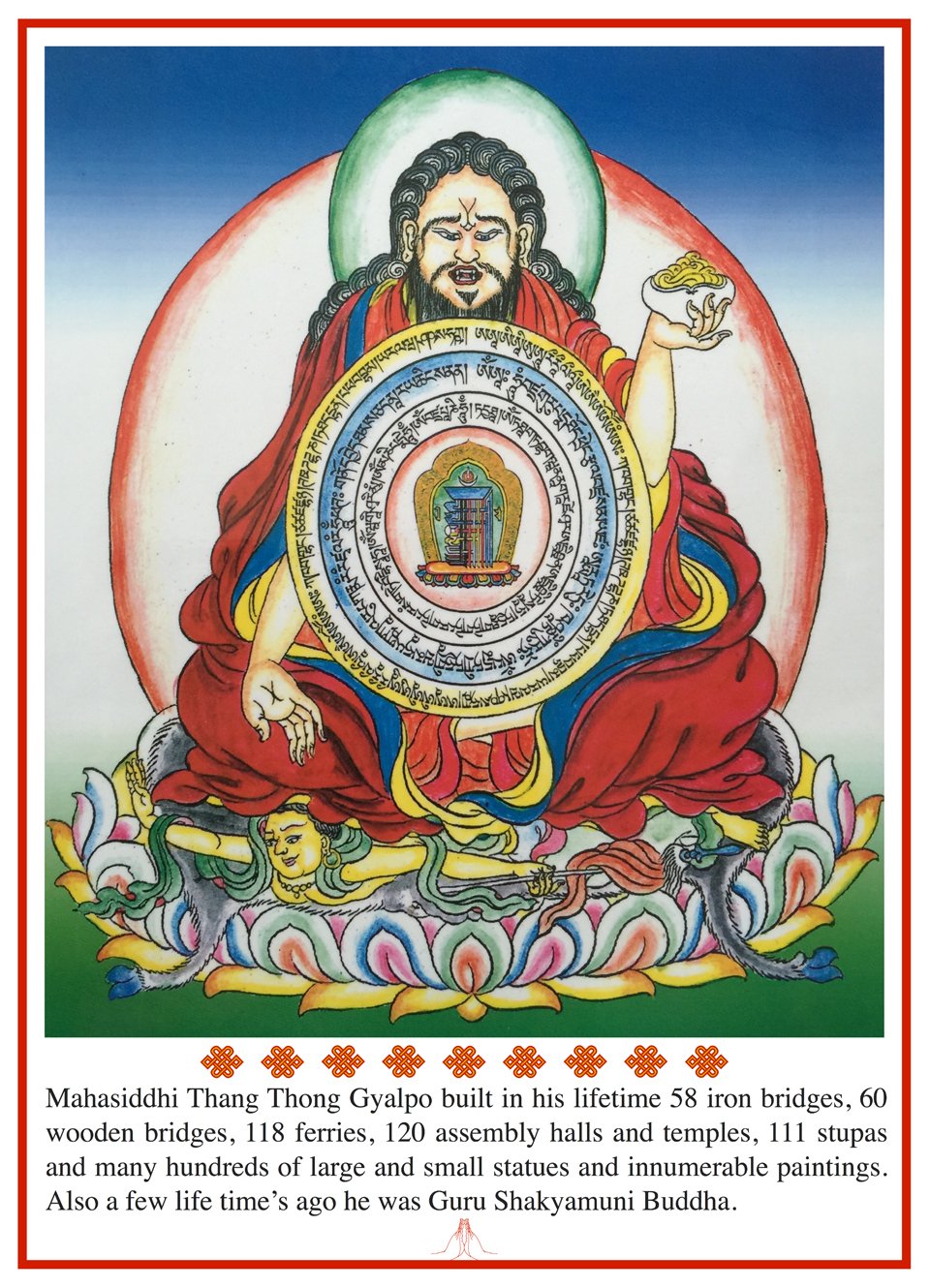
Thang Thong Gyalpo Earthquake Protection
The FPMT organization is devastated to hear the news that a powerful 6.8 earthquake struck on January 7, 2025 in the Dingri region of Tibet, with tremors felt across the Himalayas in neighboring Nepal, Bhutan and parts of northern India.
Many FPMT centers and students are doing prayers for those affected. Rinpoche has offered advice for prayers and protection from earthquakes and recommended Thang Thong Gyalpo protection image for anyone living in areas that are prone to earthquakes.
The main practices to do are:
- Ksitigharba mantra and practice (also sutra)
- Medicine Buddha
- Practices to Control Earthquakes and the Four Elements
- Lama Zopa Rinpoche also gave more extensive advice on how to think and how to benefit those who have died
We also would like to share that Kopan Monastery and Nunnery have been doing pujas for those affected, to show our solidarity and support for those who have nothing. His Holiness the 14th Dalai Lama also led prayers immediately for victims of the earthquake at Tashi Lhunpo Monastery in Bylakuppe, Karnataka.
Foundation for the Preservation of Mahayana Tradition (FPMT), is a Tibetan Buddhist organization dedicated to the transmission of the Mahayana Buddhist tradition and values worldwide through teaching, meditation and community service.
- Tagged: earthquakes
10
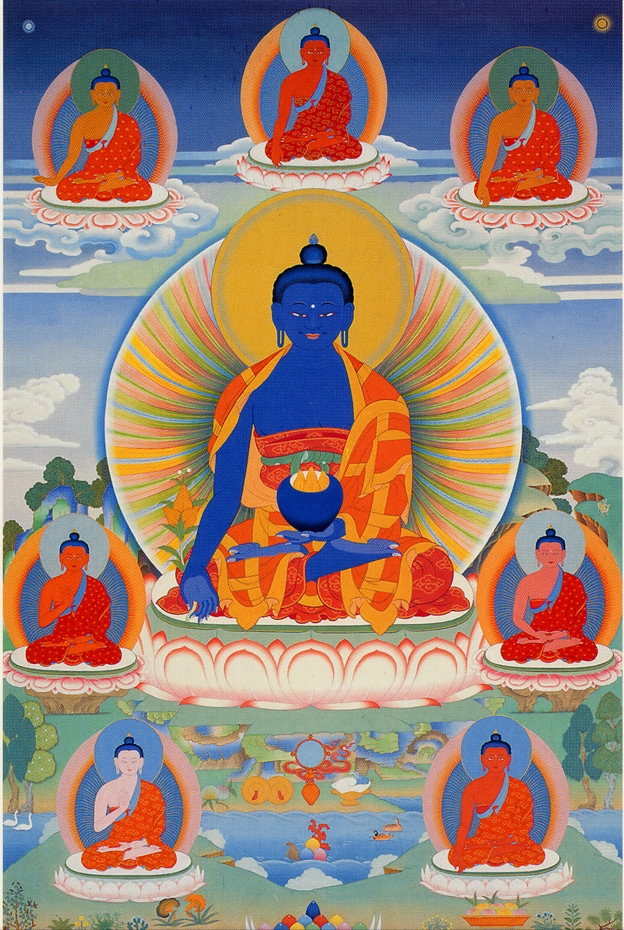
Medicine Buddha by Peter Iseli,
Lama Zopa Rinpoche has offered the following advice for practices one can do in relation to the dangers of fire, for oneself or others:
Medicine Buddha
When there are fires the best thing to do is rely on the Medicine Buddha, to do Medicine Buddha puja (which can be downloaded here).
White Umbrella Practice
There’s an Umbrella protection, prayer and mantra which can be put around your house, inside and outside, to protect from the fire.
You can also put the White Umbrella deity’s picture up. Then you should visualize that rainfalls of nectar are emitted. This nectar stops the fires, purifies the suffering of the insects, and purifies the negative karma of all the sentient beings. All are liberated.
The Heart Mantra of Arya Vairocana
Put the Heart Mantra of Arya Vairocana around the house/buildings to protect from fire danger.
Ksitigarbha Mantra and Practice
Recite the Ksitigarbha mantra and do the practice as much as possible.
Chenrezig Practice
Then also you can do Chenrezig practice. Completely rely on Chenrezig, make prayers and visualize Chenrezig in the sky, and nectar flows from Chenrezig and purifies all the causes of the fire – the main cause is negative karma.
Lama Chopa
Visualize the Lama Chopa merit field with a great stream of nectar coming from the merit field and putting out the fires and especially helping the insects and animas who are suffering and perishing in the fire. This is best done in the context of doing the whole Lama Chopa (if you have time). Showers of nectar pour down purifying the negative karma of the suffering sentient beings who are suffering from the fire and who have been destroyed in the fire, and also of all the suffering sentient beings in the six realms. Also visualize that the nectar as it pours down is changing the karma and the minds of the nagas, dergye (harmful spirits) and landlord beings, changing their negative mind so that they do not harm anymore. It’s very important that one has one-pointed refuge in the merit field while doing this practice, and that one recites the mig-me mantras while doing this visualization.
Protector Prayers
Doing protector prayers is very good, especially tea offering to dergye as they control the elements, so it is important to appease them. But you can’t just offer tea and do nothing with the mind; you have to generate great bliss and emptiness.
Please read more extensive commentary and advice from Lama Zopa Rinpoche on these practices.
Please also read advice Rinpoche offered in 2017 regarding California fires.
Foundation for the Preservation of Mahayana Tradition (FPMT), is a Tibetan Buddhist organization dedicated to the transmission of the Mahayana Buddhist tradition and values worldwide through teaching, meditation and community service.
- Tagged: disasters of the elements, fires, wildfires
9
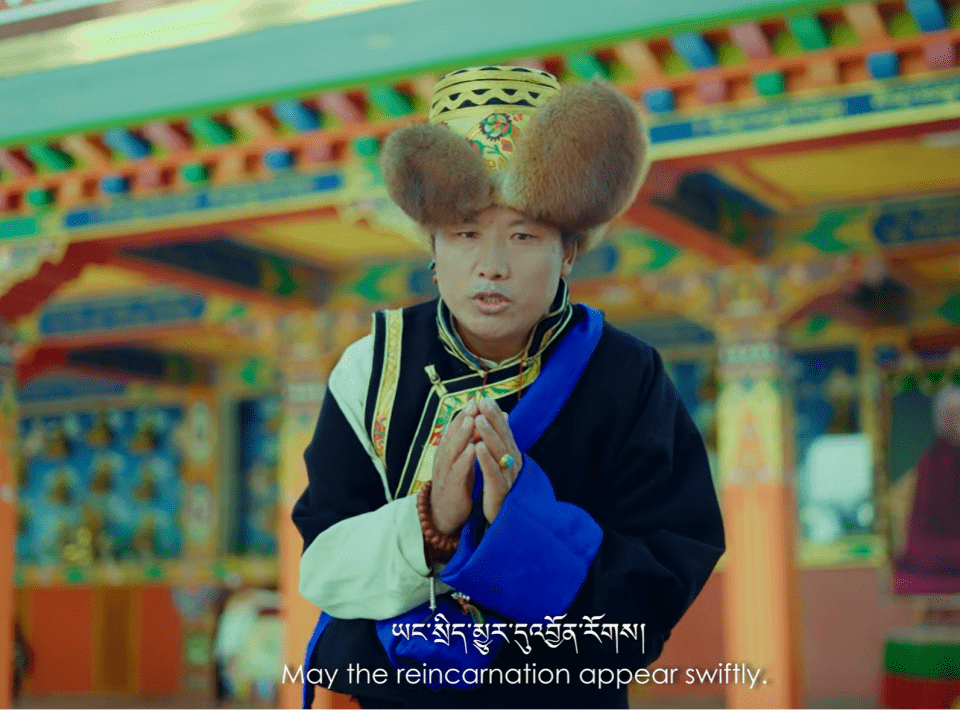
Chhiring Wangchu Sherpa offering a song of appreciation for Lama Zopa Rinpoche, and prayers for his swift return.
The Thame region of Nepal was seriously damaged during a 2015 earthquake. Thame holds a special place in our hearts as the birthplace of Kyabje Lama Zopa Rinpoche. Almost all the homes in the area were damaged and also a large very precious stupa was destroyed. The monks from Thame Monastery requested Lama Zopa Rinpoche’s help to rebuild the stupa, as it was the biggest holy object in the region. The rebuilt stupa stands nearly 46 feet tall with a base measuring 54 feet across, took two years to complete, and is larger than the one which previously stood. This impressive stupa features a large prayer wheel inside making it possible for pilgrims and locals to enter the stupa and spin it to create so much merit, even when the area is covered by snow.
A tragic flood occurred in Thame in August 2024, and fortunately the stupa was not damaged.

Completed magnificent stupa in Thame, Nepal, sponsored by Lama Zopa Rinpoche.
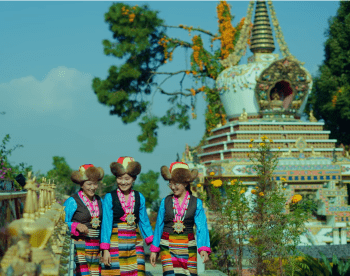
Sherpa women performing a song of appreciation for Lama Zopa Rinpoche at Kopan Monastery.
A song of appreciation was written by local Sherpas, and was meant to be offered to Rinpoche during an official consecration in June 2021, but unfortunately Rinpoche was not able to travel there due to the pandemic and restrictions. A smaller consecration occurred, as all the materials had already been prepared, and at the same time Rinpoche offered the puja and prayers and consecrated the stupa from afar at Kopan Monastery.
We are so pleased to share a beautiful, newly released version of that song of appreciation, filmed in Kopan and Thame, Solu Khumbu, and performed by Chhiring Wangchu Sherpa and others. This song also sincerely requests Rinpoche’s swift return. One of Rinpoche’s attendants, Ven. Tendar, was the kind sponsor of this production:
Lama Zopa Rinpoche (1945-2023) was the spiritual director of the Foundation for the Preservation of Mahayana Tradition (FPMT), a Tibetan Buddhist organization dedicated to the transmission of the Mahayana Buddhist tradition and values worldwide through teaching, meditation and community service.
- Tagged: holy object, thame stupa
3
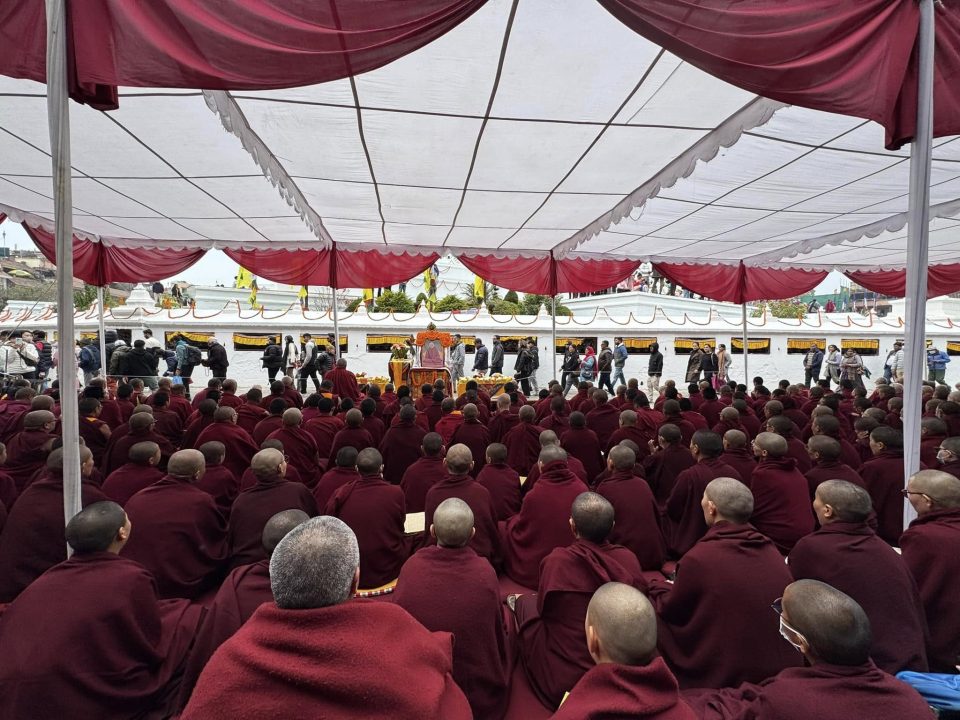
Hundreds gathered at Bouddha Stupa on December 28 to offer prayers for Lama Zopa Rinpoche’s swift return.
On December 28, 2024, Khenrinpoche Geshe Thubten Chonyi, Rigsel Rinpoche, along with the Kopan geshes, geshemas, monks, nuns, and students, gathered at the holy Boudhanath Stupa, Nepal, to recite Chanting the Names of Manjushri, the King of Prayers, Calling the Guru from Afar, and other prayers for the swift return of Lama Zopa Rinpoche. This Saturday, January 4, the same prayers will be done at Swayambhu Stupa at the site of Manjushri’s throne as well. Additionally prayers are being organized in Bodhgaya during the Fifteen Days of Miracles and elsewhere in FPMT centers around the world.
It is incredibly important to continue offering the prayers advised by His Holiness the Dalai Lama for Rinpoche’s swift return at this time. With the Fifteen Days of Miracles, starting on Losar (February 28), approaching next month, FPMT centers and individual students of Lama Zopa Rinpoche are encouraged to organize prayers themselves, in order to maximize the power on those merit-multiplying days. All are welcome to please utilize the resources available to you, in order to sincerely pray for Rinpoche’s return. Additionally, Lama Yeshe Wisdom Archive also offers Lama Zopa Rinpoche’s own commentary and oral transmission of Chanting the Names of Noble Manjushri which is available to all.
Please enjoy this video of the December 28 prayer session for Rinpoche’s swift return at Boudhanath:
As Lama Zopa Rinpoche often advised about making prayers and dedication—”they have power. It is said in the teachings, The Piled Three Precious Rare Sublime Ones Sutra (Kön chhog sum tsheg päi do), ‘All phenomena arise due to conditions, they depend on the tip of the wish.”’ We can take this advice to heart and sincerely and collectively fulfill His Holiness’s advice in order for us to find Rinpoche’s unmistaken reincarnation very soon.
Lama Zopa Rinpoche (1945-2023) was the spiritual director of the Foundation for the Preservation of Mahayana Tradition (FPMT), a Tibetan Buddhist organization dedicated to the transmission of the Mahayana Buddhist tradition and values worldwide through teaching, meditation and community service.
- Tagged: swift return prayers
18
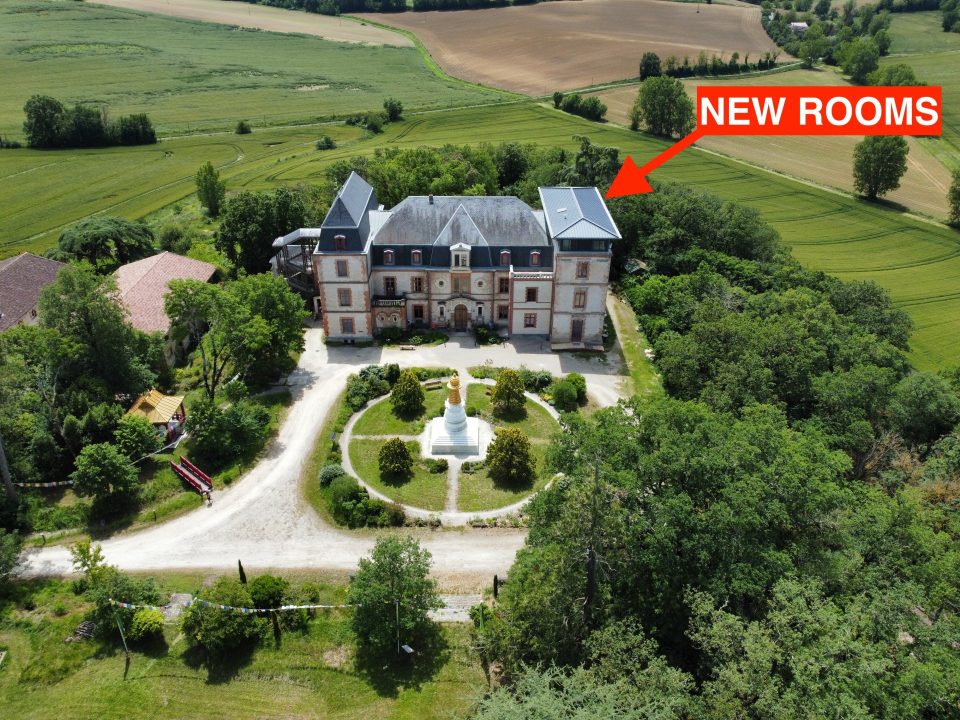
Aerial view of the new long retreat rooms at IVY.
In January 2025, Institut Vajra Yogini (IVY), France, will host its 39th Annual Vajrayogini Retreat, guided this year by Jhampa Shaneman. This retreat, open to all who have received the Vajrayogini initiation, marks a special moment in fulfilling Lama Zopa Rinpoche’s wishes.
in 2019 Lama Zopa Rinpoche expressed his vision for more people to engage in the three-year Vajrayogini retreat. IVY then brought up their wish to create retreat rooms in which people could do this long retreat, up to three years. Rinpoche immediately pledged US$120,000 to help them complete this project. Due to the kindness of a benefactor, half of this was raised in 2020 and Lama Zopa Rinpoche personally offered the rest of the pledge through the Lama Zopa Rinpoche Bodhichitta Fund the following year.
These four individual long-term retreat rooms—each equipped with a private bathroom, individually-controlled air conditioning, and space for study and practice—are designed to provide ideal conditions for practitioners undertaking extended three-year Vajrayogini retreats.
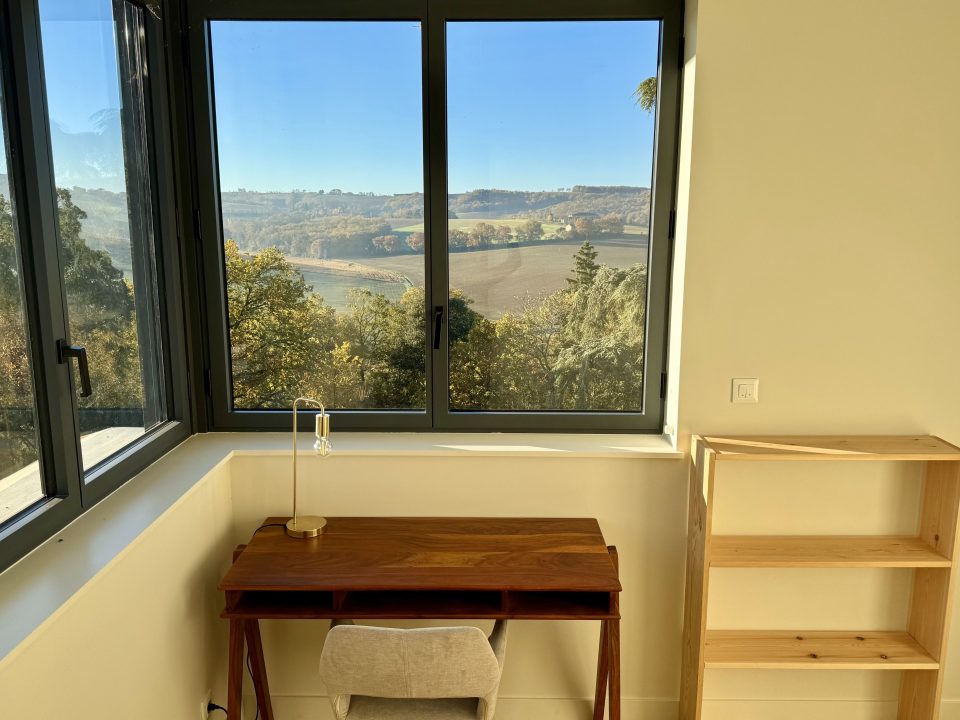
View from one of the new long retreat rooms at IVY.

View of a new long retreat room at IVY.
IVY shares, “As we welcome the energy of retreatants this January, we rejoice in the manifestation of Rinpoche’s wishes and the opportunity to dedicate these rooms to practitioners embarking on deep and transformative retreats.
“We celebrate this milestone as a profound moment for the entire FPMT community! We offer heartfelt gratitude to Lama Zopa Rinpoche for his guidance, generosity, and dedication, which continue to inspire and support practitioners at Institut Vajra Yogini and worldwide.”
To inquire about long-term Vajrayogini retreats at IVY, or to register for the January Vajrayogini Retreat, please visit their website.
With grateful thanks to IVY President Julia Lefebvre for providing details for this report.
Foundation for the Preservation of Mahayana Tradition (FPMT), is a Tibetan Buddhist organization dedicated to the transmission of the Mahayana Buddhist tradition and values worldwide through teaching, meditation and community service.
6
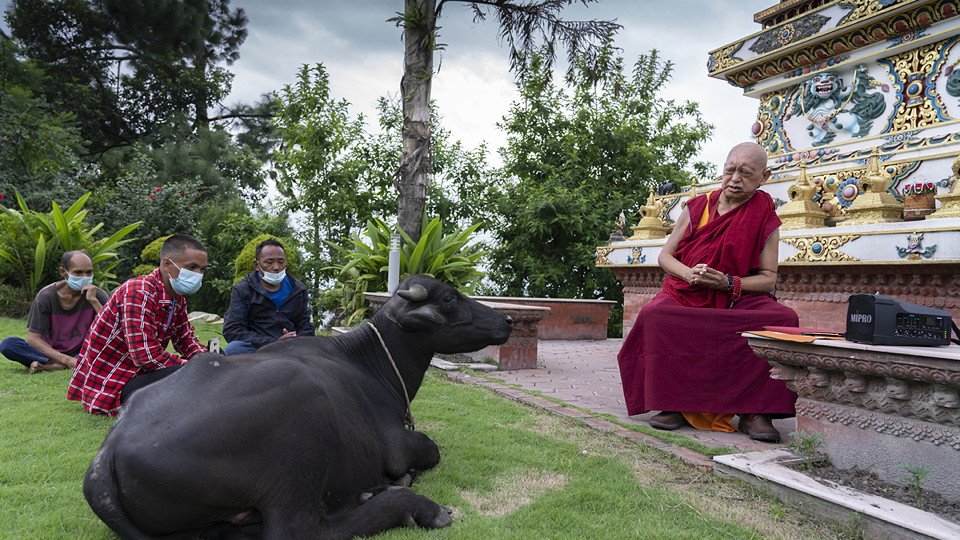
Lama Zopa Rinpoche and a young buffalo that he liberated, Kopan Monastery, Nepal, August 2021. Photo by Ven. Lobsang Sherab.
Last month we shared a report on recent beneficial activities supported by the Animal Liberation Fund. In this report we updated on a buffalo named Bodhichitta, a buffalo blessed by Lama Zopa Rinpoche in 2021. Today we are re-sharing a video of that blessing and Rinpoche personally sharing the story of how he came into contact with this special animal.
Please watch this touching video:
https://youtu.be/9sbZm1Xk_5M
Bodhichitta the buffalo is now thriving at the Animal Liberation Sanctuary at Kopan Monastery in Nepal, enjoying daily life surrounded by care and love.
Please read the full story of this buffalo, in Rinpoche’s words, from 2021.
There are many resources available for those wishing to benefit animals, including advice from Lama Zopa Rinpoche and links to practices and materials:
https://fpmt.org/education/prayers-and-practice-materials/benefiting-animals-practices-and-advice/
All are welcome to contribute to the Animal Liberation Fund to help ensure that our work sponsoring animal rescue, care, and liberation continues.
2
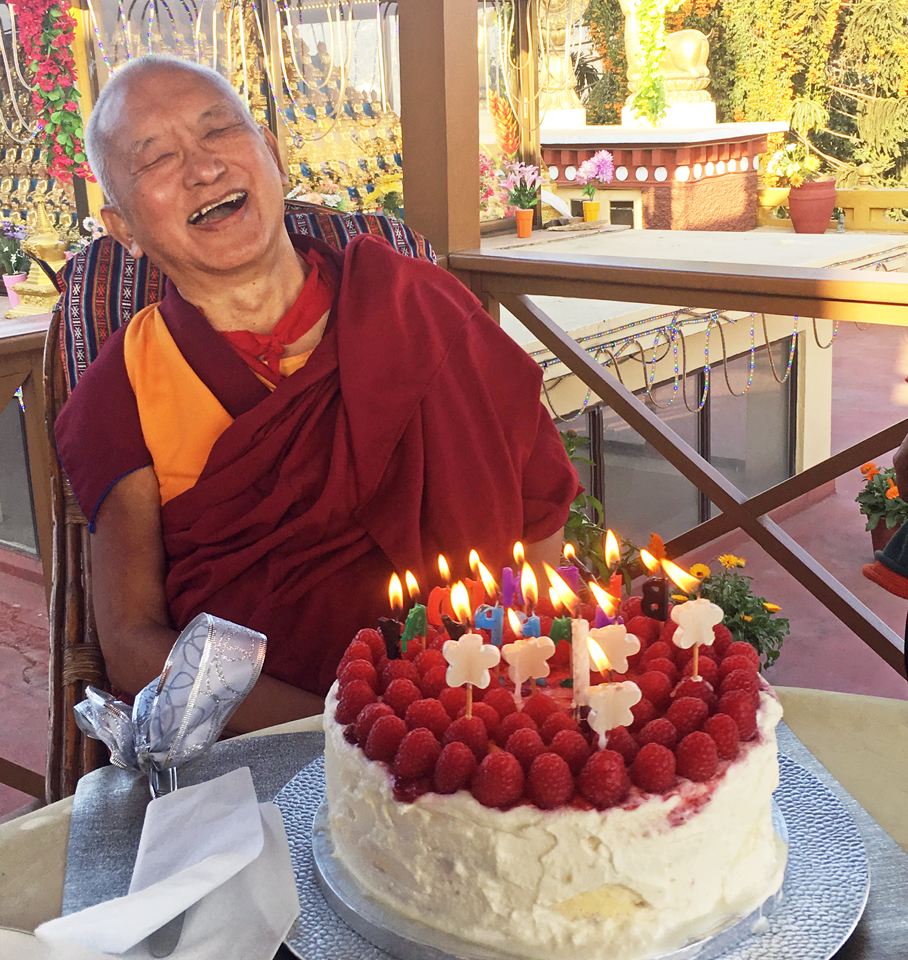
Lama Zopa Rinpoche with a birthday cake offered to him, Kopan Monastery, Nepal, 2016.
On December 3 we observe the birth date of Lama Zopa Rinpoche. As previously shared, a very large thangka of Padmasambhava (Guru Rinpoche) will be displayed and an auspicious 100,000 tsog offering event (Guru Bumtsog) will take place at Khachoe Ghakyil Ling (Kopan Nunnery) on this date in honor of Lama Zopa Rinpoche’s birthday, to commemorate Rinpoche’s life and fulfill Rinpoche’s wishes.
The event will start early in the morning of December 3, local time in Nepal, at approximately 8 a.m. and will be presided over by H.E. Jangtse Choeje Kyabje Gosok Rinpoche of Sera Mey Monastery.
Students of Lama Zopa Rinpoche are encouraged to rejoice in this auspicious and powerful event and to pray for the swift return of his reincarnation as advised by His Holiness the Dalai Lama. Please also dedicate for all of Rinpoche’s wishes to manifest without delay, and for the success of the FPMT organization.
Please read more about the large Padmasambhava thangka display and the Guru Bumtsog taking place at Kopan Nunnery:
https://fpmt.org/lama-zopa-rinpoche-news-and-advice/large-padmasambhava-thangka-display-and-guru-bumtsog-offered-on-lama-zopa-rinpoches-birthday/
Lama Zopa Rinpoche (1945-2023) was the spiritual director of the Foundation for the Preservation of Mahayana Tradition (FPMT), a Tibetan Buddhist organization dedicated to the transmission of the Mahayana Buddhist tradition and values worldwide through teaching, meditation and community service.
- Tagged: lama zopa birthday
27

Turkeys at a farm. Photo courtesy of Pixabay.
Every year in the United States, tens of millions of turkeys are killed for the holiday of Thanksgiving, which is this Thursday, November 28, 2024. Lama Zopa Rinpoche offered advice in a 2018 teaching to help benefit the turkeys killed, and how we can think during the holiday. Rinpoche explained that these practices can be applied beyond the Thanksgiving holiday, “These are simple methods, but they have unbelievably profound benefits, like the sky. You can also do more or different practices as well. These are just suggestions. You can also do these practices at Christmas or on other occasions where turkeys and so many other animals are sacrificed and eaten.”
In “Prayers and Practices to Do for Turkeys at Thanksgiving”, Rinpoche explains,
“If you are Buddhist, or just someone who does not want to suffer now or in endless future lives as well, having to experience unbelievably suffering, you need to purify your past negative karma and stop creating any more so that you will not be reborn as a turkey over and over again. … If you do have to eat turkey because of some family obligation, then at least do some mantras and prayers to benefit the turkeys, such as the four immeasurables with tonglen. Otherwise, if you just enjoy eating turkey together with the rest of the Americans who are not Buddhist, who do not know Dharma, who have not generated compassion for the turkeys, you create much negative karma.”
In this teaching Rinpoche provides detailed instructions on practices to purify negative karma, such as Vajrasattva, taking the eight Mahayana precepts, reciting sutras, engaging in nyung ne fasting retreats, generating love and compassion through the practice of tonglen and the Four Immeasureables, practicing Chenrezig, Medicine Buddha puja and specific mantras. Rinpoche also offers a special dedication to purify any negative karma that could cause future rebirth as a turkey.
Of course, Rinpoche also has given extensive advice for benefiting animals and we invite you to explore all the resources available to you.
For links to practice materials in these detailed instructions, we invite you to read “Prayers and Practices to Do for Turkeys at Thanksgiving”. Included on the page is an additional short teaching from Rinpoche which we include below:
Further Commentary and Advice for Thanksgiving from Lama Zopa Rinpoche:
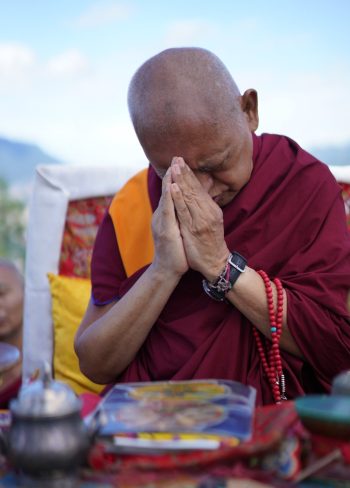
Lama Zopa Rinpoche, Kopan Monastery, 2020. Photo by Ven. Lobsang Sherab.
I don’t think the general population of America accepts clairvoyance, but if it did, people would understand where all the sufferings, such as depression, come from. The way people normally think—for example, what causes depression—is very limited. They only think about things that are to do with this life. If they had clairvoyance they could see much deeper; they could see things such as past and future lives. People normally think of only this life, not past and future lives.
In the past, many of the turkeys that Americans are eating were Americans who in the past had killed turkeys. Often it could even be a past family member that they are now eating.
There’s a sutra story about Buddha’s disciple Shariputra, who excelled in wisdom. Once when he was on his alms round he looked into a family’s house and saw that the father, who used to catch fish in his backyard pond, had died and been reborn as a fish in that pond. The mother, his wife, who had been very attached to the home, had also died and been reborn as the family dog. And the son’s enemy, who had been very attached to the son’s wife, had died and been reborn as their child. The son was holding the child, his former enemy, eating the fish, his late father, and beating the dog, his late mother, while it chewed on fish bones. Shariputra then observed, “The son is eating his father’s flesh, beating his mother with a stick, and cuddling his enemy on his lap—samsaric existence makes me laugh.”
If we have animals we have to remember this story and take care of them well. It is very important to understand the benefits of taking care of our pets and other animals by giving them food and drink. Think that you are making charity and don’t just do it out of attachment, thinking that you love the shape of the animals or something, doing everything simply for your own happiness. It’s the same with looking after your children. You create a child with attachment, for your own happiness, thinking how your life would be unbelievably happy if you had a child. Then you take care of the child, but it is for your own happiness.
It is also important to recognize and remember your animals’ most unbelievable kindness, how they have been kind to you in three ways, and then with that awareness give them food and drink. First recite OṂ MAṆI PADME HŪṂ and then blow over the food and drink to bless it. If you have mani pills, it’s good to crush them and put them into the food and drink, or even add blessed water. You don’t have to get blessed water from a lama; you can make it yourself. Whether or not you have daily commitments, recite OṂ MAṆI PADME HŪṂ and other mantras, such as OṂ PADMO UṢHṆĪṢHA VIMALE HŪṂ PHAṬ, the Mitrugpa mantra and so forth, and then blow on the water. You can recite however many repetitions of each mantra you want, like seven, ten, fifteen, or more, blow on the animal’s food or water and make prayers as well. Similarly, you can keep a bottle of water nearby and when you’ve done your commitments you can blow on the water and then use that to put on the food and water that you give to the animals.
Then make this dedication prayer:
Due to all the past, present, and future merits collected by me and all the merits of the three times collected by numberless buddhas and numberless sentient beings, may all these animals (you can also include your family members, especially your father and mother) never ever get reborn back into the lower realms but be reborn in a pure land where they can achieve enlightenment, or, if not, at least receive a perfect human body, meet the Mahayana teachings, and a perfectly qualified guru revealing the unmistaken path to enlightenment, and by pleasing the holy mind of the virtuous friend may they attain enlightenment as quickly as possible.
Finally, please remember the unbelievable benefits of making charity of food to the animals. As the Buddha said, “Anybody who makes charity well during the period my teachings exist will receive great enjoyments for 80,000 eons, even if the material that person offers is merely the size of a hair. That person will be free from pain and disease, will enjoy great happiness, will be enriched with all manner of desirable things, and will eventually achieve the result: peerless cessation and complete enlightenment.”
This advice has been extracted from the page “Prayers and Practices to Do for Turkeys at Thanksgiving,” which shares a teaching and advice given by Lama Zopa Rinpoche in Switzerland in 2018. Scribed by Holly Ansett. Edited by Nicholas Ribush, November 2020.
For more mantras and resources for mantra recitation, visit FPMT Education Services’ page on mantras. You can find a full catalogue of all FPMT prayers, practices, and advice materials on FPMT.org.
Foundation for the Preservation of Mahayana Tradition (FPMT), is a Tibetan Buddhist organization dedicated to the transmission of the Mahayana Buddhist tradition and values worldwide through teaching, meditation and community service.
- Tagged: thanksgiving
26
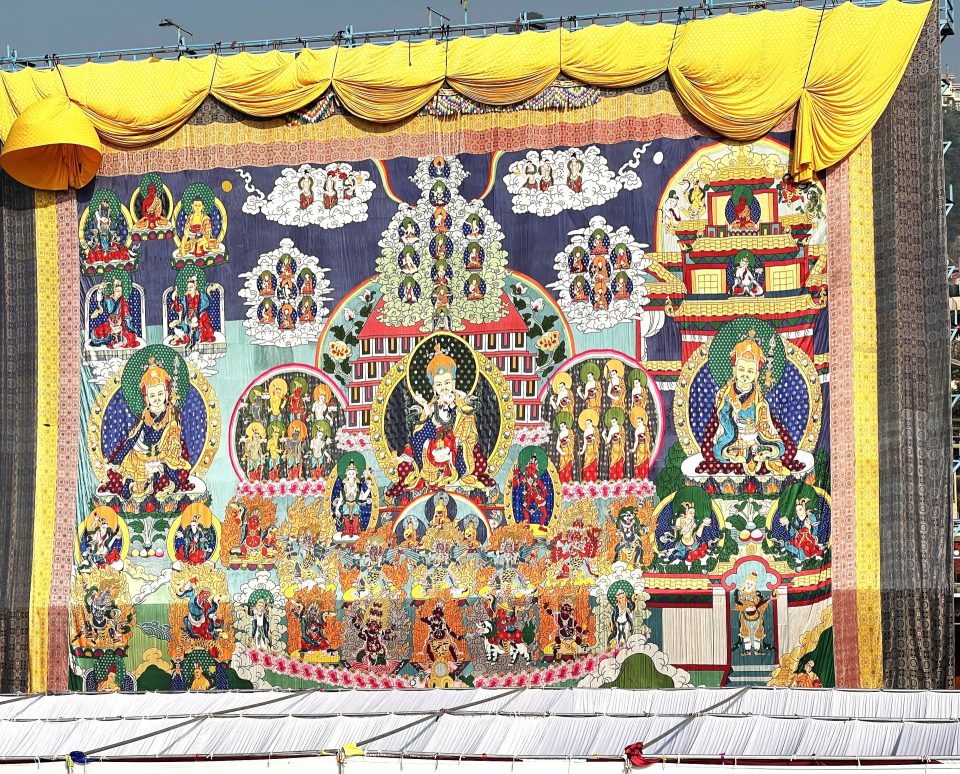
Large Thangka display and Guru Bumtsog at Kopan Nunnery, 2023. Photo by Ven. Roger Kunsang.
For the ninth year in a row, a very large thangka of Padmasambhava (Guru Rinpoche) will be displayed and an auspicious 100,000 tsog offering event (Guru Bumtsog) will take place at Khachoe Ghakyil Ling (Kopan Nunnery). This yearly event now takes place in honor of Kyabje Lama Zopa Rinpoche’s birthday, December 3, to commemorate Rinpoche’s life and fulfill Rinpoche’s wishes. Students of Rinpoche are encouraged to attend this extremely joyous annual event when one is able. The event will start early in the morning of December 3, local time in Nepal, at approximately 8 a.m. and will be presided over by H.E. Jangtse Choeje Kyabje Gosok Rinpoche of Sera Mey Monastery.
The thangka, which is 75 feet (23 meters) high and 87 feet (27 meters) wide, depicts in stitched appliqué the Padmasambhava merit field in the center. Lama Zopa Rinpoche personally designed and oversaw the creation of this huge thangka and also raised the funds for it, thanks to the kindness of two generous donors. The thangkha was also blessed by His Holiness the Dalai Lama. The incredible weight of the thangka and raising it safely up large scaffolding to display requires tremendous skill and effort. The puja is an incredible undertaking by Kopan monks and nuns as it takes days to set up and arrange, plus lunch offered to all in attendance requires major preparation.
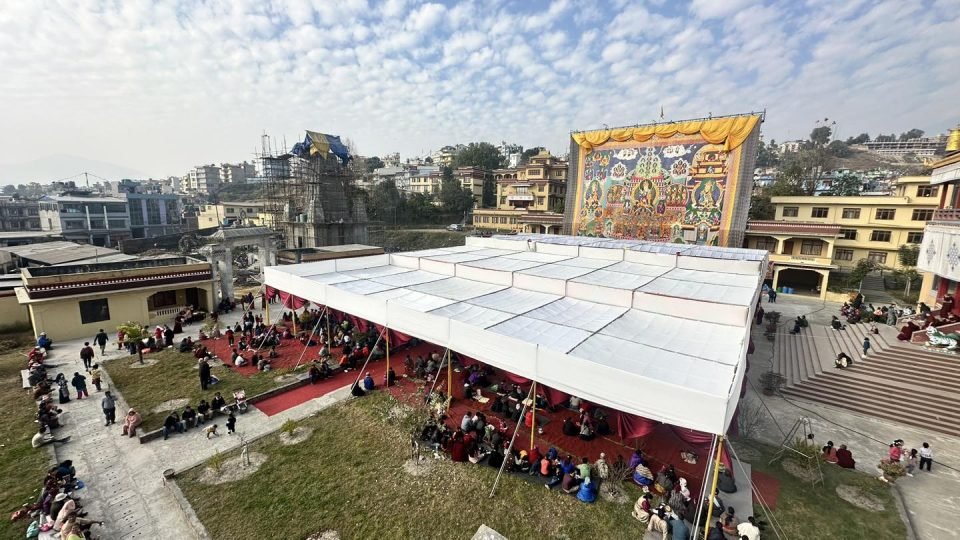
Guru Bumtsog event with the large Padmasambhava thangka on display, December 16, 2023. Photo courtesy of Kopan Monastery.
Ven. Sarah Thresher shares, “The text used [in the Guru Bumtsog] is the Sadhana of the Lineage of Awareness-Holders from the Northern Treasures cycle revealed by the great treasure-finder Rigdzin Godem. It is the same text used for Guru Bumtsog at His Holiness Dalai Lama’s temple each year and it has been translated by Bia Bispo. For those of you who are not aware, the Northern Treasures are widely practiced in Khumbu Thamichowa and this was the main lineage held by the first Lawudo Lama. So it is a wonderful opportunity to pray for a new unmistaken manifestation of the Lawudo Lama to swiftly return in magnificence!”
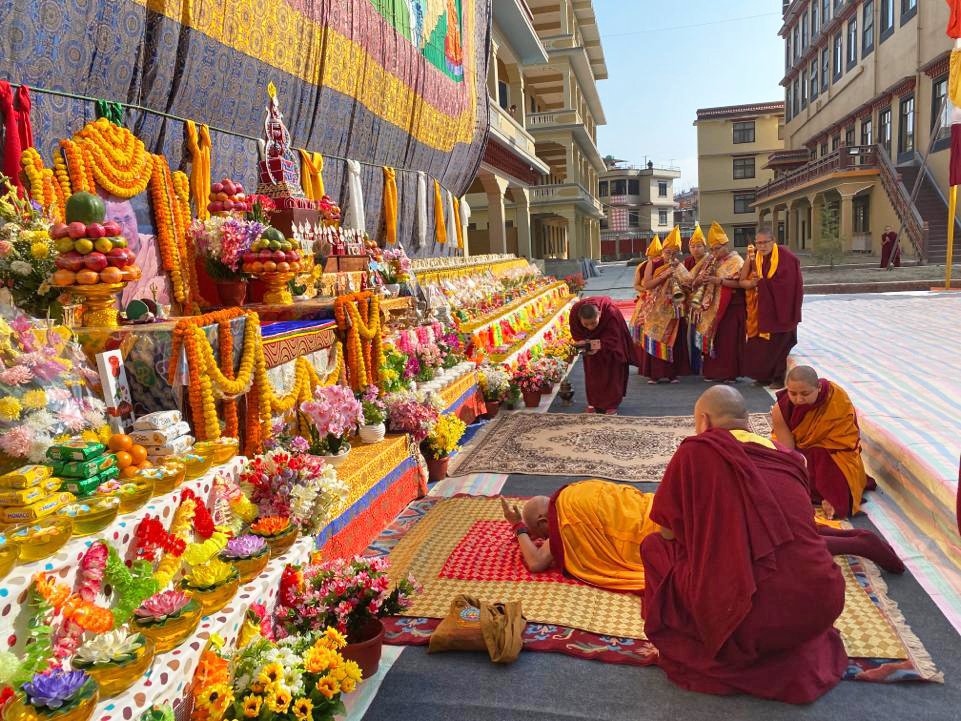
Lama Zopa Rinpoche prostrating to the giant Guru Rinpoche thangka during the Guru bumtsok at Khachoe Ghakyil Nunnery, January 2020.
Lama Zopa Rinpoche explained that displaying large thangkas is an auspicious way for anyone in the area to make a Dharma imprint and connection to the deity depicted. “You may think that a statue or thangka is just a statue or thangka,” Rinpoche has said, “but it is the transcendental wisdom of dharmakaya, which understands and directly sees absolute truth, as well as conventional truth.”
Rinpoche also expressed that it is his wish for many FPMT centers to have huge thangkas and once a year to display the thangka and have a festival day for the public based around the holy object. During the festival day, Rinpoche requested for there to be many thousands of offerings in front of the thangka, as well as offering banners.
Students of Lama Zopa Rinpoche are encouraged to rejoice in these events occurring on December 3 as a way to honor Rinpoche’s extremely beneficial and inspiring life, and to dedicate the merit for the swift return of his unmistaken reincarnation. Students are also reminded of the practices advised by His Holiness the Dalai Lama. All swift return prayers have been compiled for ease of use.
Please rejoice in this auspicious yearly event which is fulfilling Lama Zopa Rinpoche’s Vast Visions for the FPMT organization, and has profound effects on those in Nepal and the entire world. The costs of offering this yearly event are substantial and will be covered this year by two very kind benefactors.
The Puja Fund was established by Lama Zopa Rinpoche to provide resources for continuous pujas dedicated to the long life of His Holiness the Dalai Lama and to the success of all the FPMT centers, projects, services, students, benefactors and those serving the organization in any way.
24
This eulogy is also available to read on our website with translations into several languages.
Here we share on chapter from this beautiful tribute, describing Rinpoche’s early life:
“That Is My Home!”
Lama Thubten Zopa Rinpoche was born at sunrise on December 3, 1945, the last day of the tenth month of the Wood Bird year in the Tibetan lunar calendar, in Thangme, a village in the Khumbu region of Nepal, up in the Himalayas.
It was evident from the time he was two or three years old that he knew what he wanted. One of many children of a Sherpa family — he was called Dawa Chötor then — the moment his mother, Yangchen, turned her back, fetching water, checking on the potato fields, or collecting wood, he’d be gone, determinedly trudging his way up the long, steep, winding path that led to the cave of the Lawudo Lama, the revered local yogi Kunsang Yeshe who’d died a couple of years earlier.
They’d find him asleep in the resting place halfway up the mountain, his sister Ngawang Samten said. When they’d admonish him to “come home!” he’d point up towards the cave and say, “No, that is my home!”
Ani Samten said that somehow he was different from the other children, sitting apart, or sitting on a high box when he ate his meals. And when he’d play games, he’d always play the role of the lama: he’d lead pujas, give initiations, and announce the names of the Lawudo Lama’s benefactors, saying they’d be coming.
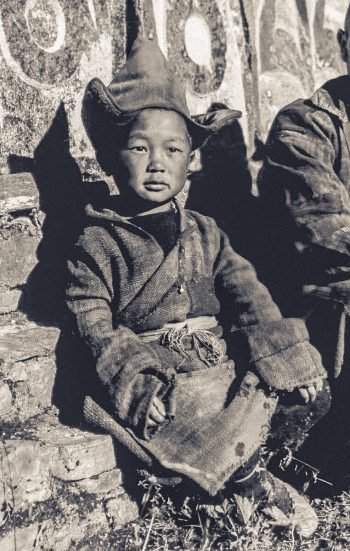
Lama Zopa Rinpoche as a child in Rolwaling. Photo by Tom Weir
When he was three, Rinpoche was delighted when the Lawudo Lama’s attendant, Ngawang Chöpel, came to visit. He cried and cried when he was leaving, declaring that he must go with him. Although soon recognized as the unmistaken reincarnation by many lamas, including the beloved local lama, Trulshik Rinpoche, it wasn’t until years later that the family of Lama Kunsang Yeshe, who was a lay yogi, accepted.
When he was five he was sent over the mountains to Rolwaling, west of Khumbu, to be educated by one of his uncles.
It was here, in 1952, that he first laid eyes on people with “white eyes and yellow hair,” as the Sherpas described Westerners, a group of them camping in a meadow on the other side of the river. Eager to meet them, he crossed the river on the makeshift bridge but fell into the water with his gift of boiled potatoes before reaching the other side. Rinpoche recounted later that while he was struggling to keep his head above water the thought occurred to him that the person known as the Lawudo Lama was about to die, but although he didn’t know anything about emptiness, “there was no fear.”
You can read the full eulogy written by Ven. Robina online, or download the newly available PDF for mobile phones and tablets.
Lama Zopa Rinpoche (1945-2023) was the spiritual director of the Foundation for the Preservation of Mahayana Tradition (FPMT), a Tibetan Buddhist organization dedicated to the transmission of the Mahayana Buddhist tradition and values worldwide through teaching, meditation and community service.
- Tagged: lama zopa rinpoche obituary
- Home
- News/Media
- Study & Practice
- About FPMT Education Services
- Latest News
- Programs
- New to Buddhism?
- Buddhist Mind Science: Activating Your Potential
- Heart Advice for Death and Dying
- Discovering Buddhism
- Living in the Path
- Exploring Buddhism
- FPMT Basic Program
- FPMT Masters Program
- FPMT In-Depth Meditation Training
- Maitripa College
- Lotsawa Rinchen Zangpo Translator Program
- Universal Education for Compassion & Wisdom
- Online Learning Center
- Prayers & Practice Materials
- Overview of Prayers & Practices
- Full Catalogue of Prayers & Practice Materials
- Explore Popular Topics
- Benefiting Animals
- Chenrezig Resources
- Death & Dying Resources
- Lama Chopa (Guru Puja)
- Lama Zopa Rinpoche: Compendium of Precious Instructions
- Lama Zopa Rinpoche: Life Practice Advice
- Lama Zopa Rinpoche Practice Series
- Lamrim Resources
- Mantras
- Prayer Book Updates
- Purification Practices
- Sutras
- Thought Transformation (Lojong)
- Audio Materials
- Dharma Dates – Tibetan Calendar
- Translation Services
- Publishing Services
- Teachings and Advice
- Find Teachings and Advice
- Lama Zopa Rinpoche Advice Page
- Lama Zopa Rinpoche: Compendium of Precious Instructions
- Lama Zopa Rinpoche Video Teachings
- ༧སྐྱབས་རྗེ་བཟོད་པ་རིན་པོ་ཆེ་མཆོག་ནས་སྩལ་བའི་བཀའ་སློབ་བརྙན་འཕྲིན།
- Podcasts
- Lama Yeshe Wisdom Archive
- Buddhism FAQ
- Dharma for Young People
- Resources on Holy Objects
- Ways to Offer Support
- Centers
- Affiliates Area
- Teachers
- Projects
- Charitable Projects
- Make a Donation
- Applying for Grants
- News about Projects
- Other Projects within FPMT
- Support International Office
- Projects Photo Galleries
- Give Where Most Needed
- FPMT
- Shop
Translate*
*powered by Google TranslateTranslation of pages on fpmt.org is performed by Google Translate, a third party service which FPMT has no control over. The service provides automated computer translations that are only an approximation of the websites' original content. The translations should not be considered exact and only used as a rough guide.The minute you cherish others, you have happiness and peace in your life.







